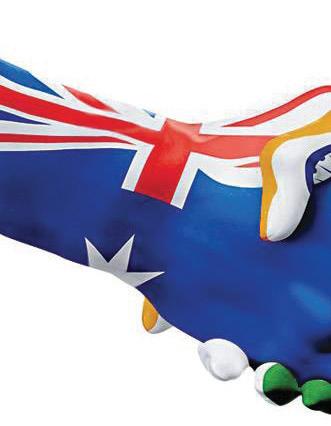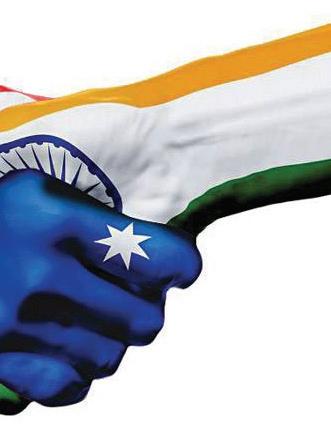
16 minute read
India News-JGU-IAIE SMART program
JGU has signed Memorandums of Understanding (MOUs) with Australia-based INDIA NEWS and Institute for Australia India Engagement (IAIE) to create opportunities for students to undertake internships in Australia. With INDIA NEWS and IAIE students will participate in the Student Mentoring and Research Training (SMART) program over a period of 1-2 months. As a part of the internship students design, edit and publish this page which contains commentaries by them on issues which they deem relevant for Australia-India relations.
Page Editor: Ms. Anushka Saxena, Lady Sri Ram College (graduate), New Delhi
Advertisement
Associate Page Editor: M s. Vaibhavi Nagar, JGU
Commentators: Mr Dhruv Kumar Jha, Ms. Harshita Calla, Ms. Sumedha Maheshwari, Ms. Sri C. Khyati Reddy, Mr. Shivam Shukla and Ms. Tanya Goel ( JGU students and graduates)
Australia’s food culture

Harshita Calla
To understand Australia’s food culture, we need to take a quick look at its history. Before Australia became a settlement, aboriginals inhabited the continent, and they survived by consuming native plants and animals - a unique huntergatherer diet called bush tucker. The food habits of the settlers were influenced by the tastes of the British and Irish migrants. Chinese influence was introduced during the Australian gold rush, with food becoming more diverse due to the post-war immigration. After the World War I, immigrants brought influences from South Asia, the Mediterranean and East Asia. Cut to the Australian cuisine of the 21st century, which is influenced by globalisation, has had a long history of evolving tastes and flavours. It is accompanied with the rising popularity of international restaurants and fast-food chains.
The most popular meat in Australia is chicken, with the average Australian consuming around 47 kgs of chicken every year. Another common meat is lamb, with it being used in many cuts – chops and shanks being the most popular ones. Lamb is a popular dish that is served for Sunday Roasts and barbecues. Along with food, Australia has had a distinct coffee culture from the beginning of the 20th century. An interesting thing to note about the coffee culture of Australia is that the international coffee chains like Starbucks have a small market share, while the native brands of Australia, like The Coffee Club and Zarraffas Coffee, are much more popular. One explanation for this can be that Australia harboured an independent, entrenched coffee culture, and the American brands entered the Australian market late.
The fact that Australians are foodies with historical food traditions, is no secret. A famous Australian bread that dates back to the 1920s is the fairy bread, and is commonly served at children’s birthday parties. There also exist regional foods like YoYo biscuits and Balfours frog cakes. Popular desserts in Australia are the pavlova and various meringue-based desserts. The lamington cake, which is made from two squares of a butter or sponge cake and coated with an outer layer of chocolate and desiccated coconut, is also a popular dish. Clearly, Australian food makes the country a hotspot for food-lovers from around the world!
New Quad, new stakes: The US-Pak-Uzbek-Afghan era

On 16 July, 2021 the United States President Joe biden announced the formation of a new Quad among the US, Uzbekistan, Afghanistan and Pakistan. Strategically, the move aims to keep interregional trade routes alive, and the Afghani peace process going, even though the withdrawal of US troops is being rapidly executed. “The parties consider long-term peace and stability in Afghanistan critical to regional connectivity and agree that peace and regional connectivity are mutually reinforcing. Recognizing the historic opportunity to open flourishing interregional trade routes, the parties intend to cooperate to expand trade, build transit links, and strengthen business-to-business ties,” said an official US press release. Clearly, there exists a lot to unpack here, considering this move shows the US inability to fully move out of its Afghani stronghold, knowing that border security and trade with Central Asia will prove to be a major earner for the Americans. At the same time, the non-involvement of India in the new Quad signals a slight shift away from the goals of “peace” and “trade stability,” and I’d like to demonstrate why.
It is a known fact that Afghanistan is central to connectivity between the Central Asian Republics (CARs)— Turkmenistan, Tajikistan, Uzbekistan, Kazakhstan and Kyrgyzstan, and South Asia. The country is now under the politico-military grip of the Taliban, a body that is becoming increasingly aggressive with the closure of US military bases, claiming to have 85% of Afghanistan under its control. In this light, the stakeholders to the Afghani peace process are not just the Afghani government and Taliban itself, but also the more violent local militias that historically opposed Talibanirule and fought the organisation in the 1990s, the US, of course, and the surrounding nations like the CARs, Pakistan, India, and Iran. All these nations are becoming calmer and friendlier in their approach to the Taliban - an unprecedented move away from most of their foreign policies - especially India’s and Uzbekistan’s, both of which did not recognise Taliban at one point, and now for the sake of peace and prosperity of the region, have come back on the negotiating table. Two other “superpower” stakeholders are China and Russia, both having their own stakes in the region. Historically, Russia has been a dominant aggressor and trader in the CARs and Afghanistan and China, on the other hand, is becoming the biggest marketshare-holder, especially in terms of trade in Central Asia. But it’s not just these nations that are altering their policies, but non-state actors too. In a recent statement, a senior Taliban official stated, “We care about the oppression of Muslims, be it in Palestine, in Myanmar, or in China, and we care about the oppression of non-Muslims anywhere in the world. But what we are not going to do is interfere in China’s internal affairs.” The new Taliban stance is going to make the China-Taliban relations more workable than before.
China offered to train young Afghan soldiers in China (statement of the Chinese Ambassador to Afghanistan, September 2018), and has also engaged Afghanistan in several strategic Belt and Road projects such as the ‘Sino-Afghanistan Special Railway Transportation Project’ (focused mainly on North Afghanistan), the ‘Fibre Optic network’ project linking China with the Wakhan border, and even the China-Pakistan Economic Corridor. Not only this, China has also extended more than US $70 million in military and humanitarian aid to Afghanistan since 2016. In this context the Quad can be seen as a countervailing rival force to increasing Chinese influence in the region. The Russia dominated Collective Security Treaty Organization, which also maintains peacekeeping and peacebuilding in the region, also needs to realign its strategic priorities. Uzbekistan, which shares a 90-mile border with Afghanistan, withdrew from the CSTO in 2012, in a bid to boost ties with the US and to take a first step in lowering Russian dominance among the CARs. In this light, it’s no surprise that Uzbekistan has found a new friend in the US through the Quad, and while the country is still hesitant to welcome Afghani refugees and military personnel, it is actively playing a peacemaker in Afghanistan.
Russia too has the Afghani Opium trade up its sleeves. On 8 July, 2021 the consultations of the Russian Special Presidential Representative for Afghanistan Zamir Kabulov, with a delegation from the Taliban’s political office, released a statement, “... the Taliban is firmly determined to ward off the threat of ISIS in Afghanistan and eradicate drug production in the country after the end of the civil war.” This may be acceptable to stakeholders like Russia, the US, and India, even though the cessation of trade may not come immediately. This new understanding may help Taliban strengthen its image in the eyes of Russians with whom they have had a difficult relationship.
India’s involvement in the new Quad, even if in an observer like mandate, similar to the Old Quad plus, is essential, if President Biden’s statements on the New Quad is to be actioned upon successfully. India is an important stakeholder in Afghanistan, having invested millions in Afghanistan for post-conflict reconstruction and peacebuilding including, the Indo-Afghan Friendship Dam for US $290 million, the new Afghani parliament for US $90 million, and the Delaram-Zaranj Highway in Afghanistan, connecting Afghanistan to the Chabahar port in Iran, costing India US $135 million. India also realises that given its enduring presence and investment in Afghanistan and support to intra-Afghan peace talks, it needs to remain plugged in the restive region. India and Russia too are together working on operationalising the International North-South Transport Corridor. The Iran Afghanistan connectivity too is significant, considering it’s the only trade project that stays clear of Pakistan or China in the region.
To conclude, the New Quad signals a new era in the Afghan peace process, which remains prisoner to Pakistan’s support to Taliban. CSTO can help enable a more peaceful transition in Afghanistan in collaboration with the New Quad. India’s involvement as a strategic, trade and peacebuilding partner is critical as well. Similarly, the central Asian republics CARs too will have to keep a vigilant eye to ensure that that troubles in Afghanistan do not spill over into their territories.

Anushka Saxena
Why are Cubans Rallying?

Vaibhavi Nagar
The small island nation of Cuba, with a population of about 11 million people, erupted into protests beginning July 11th, 2021, over food and medicine shortages. The COVID-19 pandemic exacerbated the economic crisis in Cuba and the Cuban economy contracted by 11% in 2020. On July 14, 2021 in a speech to address these protests, the current Cuban president Miguel Diaz-Canel partly blamed the US embargo against Cuba for the economic crisis in the country today. Thousands of Cubans attended a rally in Havana on July 17, to denounce the US blockade and show support for the current administration. But the Diaz-Canel administration played down the US embargo and is instead taking steps to better the economic conditions of the country. These steps indicate his plans to further liberalize the economy to mitigate the effects of the economic crisis. For example, this year the Cuban government eradicated the dual currency system, reduced subsidies for state-run enterprises allowing the private sector to expand, and lifted the tariffs on food and medicine imports.
There is an ongoing debate about whether what’s currently happening in the country is a product of the contentious US embargo on Cuba or of the 60 years of socialist failures. Progressive US Congressmen such as Bernie Sanders have blamed the blockade for hurting the Cuban economy and have called for an end to it. Meanwhile, conservatives such as Marco Rubio have claimed that the Cuban economic crisis is a product of its ineffective governance structure. Previously, the Obama administration had provided some relief to Cuba by easing the US sanctions against it and had promised to bring in more tourists to the Island. The Trump administration reversed these changes, furthering the Cuban endeavour to end the embargo.
To understand the current crisis let us have a quick look at the history. The US had won Cuba along with Puerto Rico and the Philippines from Spain, following Spanish-American War of 1898. The US then imposed the Platt Amendment on Cuba and by 1950, corporate America became a major controller of Cuba’s sugar production, telephonic and electric services, and public railways. In 1959, anti-imperialist revolutionists led by Fidel Castro and Che Guevara overthrew the US-backed military dictatorship in Cuba, under Fulgencio Batista. The new socialist regime nationalized Cuban resources and managed to reduce the American corporate influence. However, the US remained strongly opposed to Fidel’s model of governance and took several steps to destabilize Cuba. On April 6, 1960, for example, the then Deputy to Assistant Secretary of State for Inter-American Affairs released a memorandum explicitly stating, “every possible means should be undertaken promptly to weaken the economic life of Cuba,” to oppose Fidel’s communist regime. The US continues to justify this embargo with the explanation that it came into existence because of the fear of a Cold War, even though it ended 25 years ago.
After the blockade was imposed on Cuba in 1960, its exports fell from a staggering 60% to merely 5% in 1961. It has been estimated that the blockade has cost the country more than $130 billion over the last 60 years. This blockade is considered unlawful under international law. As reported by Branco Marcetic, “A blockade — distinct from an embargo, by including imports and trying to coerce third-party countries — is a method of war that, under international law, is meant to only take place during armed conflict.” Scholars of law argue that the US blockade on Cuba is a serious violation of international law, because it seeks the change in government. For 29 consecutive years, the UN General Assembly has resolved to end the Cuban blockade, with 184 of 195 countries voting against it. The only two countries that voted in favour of continuing the blockade were the US and Israel. Moreover, the US role in interfering with the island of Cuba is not just restricted to the blockade. Big media houses and western press have played a significant role in spreading misinformation and highlighting the recent Cuban protests. Multiple media outlets incorrectly used a picture of a pro-government rally with thousands of Cubans to describe it as an anti-government protests. So the question arises what have these protests achieved? The anti-government rallies have been successful in pressurizing the Diaz-Canel government to take several steps to liberalize the economy, such as easing custom restrictions, reducing subsidies for state-owned businesses, and removing the dual currency system. The pro-government rallies, on the other hand, have shed a light on the cruel and antihumanitarian consequences of the illegal blockade. As one of the only five countries in the world running a communist model of governance, the socioeconomic success of Cuba can demonstrate a viable alternative to the current capitalism oriented model of governance imposed largely by the Global North. The western press increasingly depicts socialism as a threat to the US-led world order despite the fact that smaller, developing nations have witnessed growth under it. In fact, Cuba had one of the lowest COVID-related death rates in Latin America, largely credited to its community-based medical system. This is not to say that Cuba has a near-perfect model of governance, and the country does have internal political issues that need to be addressed and resolved. Cuba faces severe economic problems, but these problems to a large extent have been exacerbated by the US blockade, and more recently, by the COVID-19 pandemic. So, for how long can the political outlook of a regime be an alibi for the unlawful blockade? Cuba deserves a chance to rid itself of US interference.

Australia’s climate crisis is raging
Before COVID-19 even existed, the Australian bushfires were making headlines. The Black Wednesday of 2019-20 claimed the lives of hundreds, and vastly ravaged large tracts of green cover and forests. A state of disaster was declared, and the armed forces were called in to deal with the inferno and damage. Although seasonal bushfires are common in Australia, never has the country seen fires of this intensity. For many climate change activists and scientists, the increasing temperature of the country was to blame. Eighteen months later, extreme rainfall on the east coast led to widespread flooding and forced thousands to evacuate. A 2018 “State of the Climate” report by the Australian government's Bureau of Meteorology revealed an increase in heat by just over one degree celsius since 1910.
According to a 2021 U.N. report, Australia was ranked last in its response to climate change among 70 U.N. members. It ranked among the top three for exported greenhouse gases, among the top ten for per-capita fossil fuel, and second-worst for carbon pricing scores. It is clearly not a good mix. Australia is not doing enough to offset its contribution to the climate crisis. The country recently narrowly avoided an "in danger" rating for the Great Barrier Reef. The International Union for Conservation of Nature (IUCN) and the UNESCO World Heritage Centre had put forth a recommendation on the basis of Australian scientific experts analyzing the reef's state of health. There has been significant damage to the reef due to climate change and extensive coral bleaching that needs immediate attention. However, climate change antagonists have steadily refused to buy the climate change narrative and have blamed politics behind the global warming. There is a background of toxic politics that has been overshadowing the science, but not what this group thinks it is.
Their main point of contention against moving to clean energy is that fossil fuel industries in Australia are an essential source of jobs. This is seen as affordable energy that businesses need to retain their competitive edge. Climate action is seen as something that comes with a considerable price and is unnecessary. This narrative is highly damaging because while Australia is the biggest culprit of greenhouse gas emissions, it is also the one that is most affected by it. The bushfires may cost over A$103 billion in property damage and economic losses, according to economists. Eastern Australia floods this year led to higher food prices, crop loss, as well as heavy infrastructure and property damage. Meanwhile, the pandemic also ate into Australia's economy.
The proposal to get Australia back on track is through a ‘gas led recovery.’ At the same time, other countries are on a different path and have pledged to net-zero emissions. Recently, the European Union, ahead of the COP26 United Nations climate summit in November, shared its carbon border tax. China also revealed its carbon trading scheme. Even Japan, which is Australia's most significant customer for coal and gas, has said that it will decrease the use of the two in its energy production. So, Australia will have to change its policies because international pressure is very likely to increase in this direction. Businesses in Australia will be impacted instead of being competitive if policies don't follow a similar trend. The Treasury's 2021 Intergenerational Report said that the export earnings from the emissions-intensive commodities would fall as other countries intensify climate action.
Even its domestic businesses have started outsourcing. Australian Ethical has said that it might be forced to invest more in offshore companies because there is a lack of opportunities to fund clean energy in Australia. This is the country's original "deepgreen" fund manager. Australia still has not pledged to net-zero carbon emissions by 2050. Netzero emissions mean balancing the amount of greenhouse gas emissions produced and the amount removed from the atmosphere. Prime Minister Scott Morrison has said the country will "get there as soon as we possibly can." But according to the International Energy Agency's "Net Zero by 2050" roadmap report, Australia is currently on no path to net-zero emissions. By 2030, it is slated to emit only 7% less than 2020. By the time Australia gets there, it will cook itself alive by its own hand.
In the last few years, 80% of Australian voters have said that they care deeply about climate change and think more should be done to reduce greenhouse gas emissions. In May 2021, students across Australia took to the streets for the School Strike 4 Climate. Increasingly, Australia's citizens want climate justice. The lack of federal policies or climate action at the Centre has led to states and territories taking matters into their own hands. They are committed to net zero emissions by 2050 and have invested heavily in clean energy and renewable energy. For instance, in New South Wales, an energy bill was passed to build the world's largest battery for energy storage. The diverging views on climate change have led to a divide in the political arena between the Centre and States. Australia needs to catch up with its own people as well as the international arena. It should come up with a comprehensive climate policy to follow. Action, not hesitation, should be the mindset of the government going forward.

Sumedha Maheshwari










